Intel Core 2 Quad Q9550S: A New 65W Quad-Core
by Anand Lal Shimpi on January 27, 2009 8:00 PM EST- Posted in
- CPUs
Adobe Photoshop CS4 Performance
To measure performance under Photoshop CS4 we turn to the Retouch Artists’ Speed Test. The test does basic photo editing; there are a couple of color space conversions, many layer creations, color curve adjustment, image and canvas size adjustment, unsharp mask, and finally a gaussian blur performed on the entire image.
The whole process is timed and thanks to the use of Intel's X25-M SSD as our test bed hard drive, performance is far more predictable than back when we used to test on mechanical disks.
Time is reported in seconds and the lower numbers mean better performance. The test is multithreaded and can hit all four cores in a quad-core machine.
Before we get to performance let's look at idle power consumption:
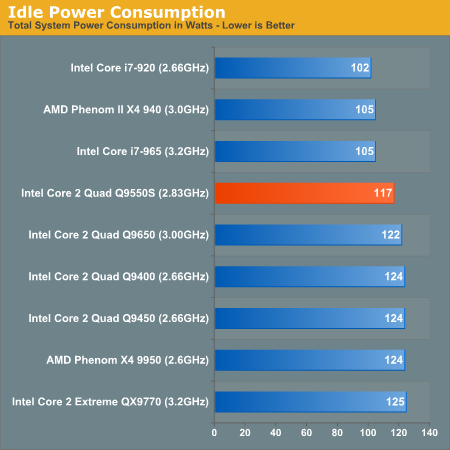
Now let’s look at performance:
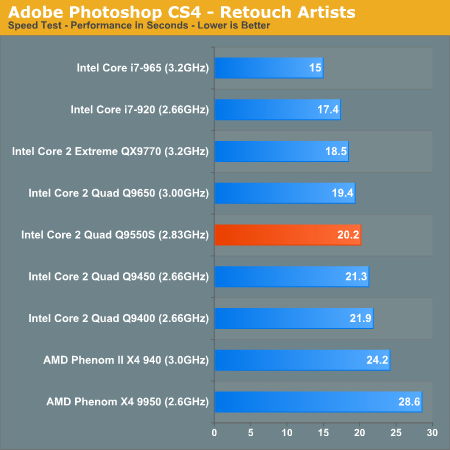
The best performers in this benchmark, by far, are the Core i7 processors. If you’re building the ultimate Photoshop machine, Core i7 is what you want. The entry level Core i7-920 is faster than the Core 2 Extreme QX9770, despite the latter being priced at over $1000.
Note that the Core 2 Quad Q9550S performs identically to a Core 2 Quad Q9500; right in between a Q9650 and a Q9450, just as you’d expect.
Next we measured the average power consumption of the entire machine during the Photoshop benchmark, the results are reported in watts. Lower numbers are better here:
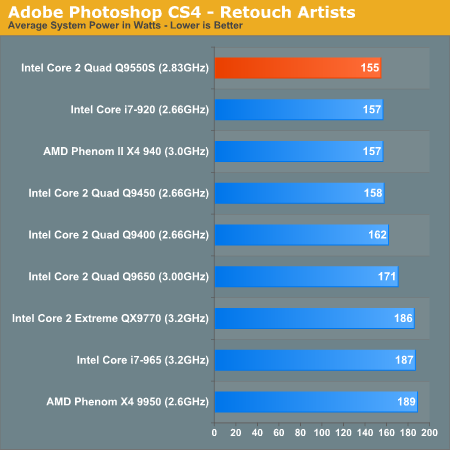
Now we see the benefit of the new -S parts; the Core 2 Quad Q9550S draws less power than any other chip we tested, including the much smaller, cooler running Q9400. While the Q9550S still uses the original 820M transistor Penryn core, the Q9400 is a smaller 456M transistor part.
While we don’t have a real Q9550 to compare to, if you look at the power consumption of the Q9650 and the Q9450 you can estimate that a Q9550 would be somewhere in between - perhaps around 165W. That would put the average energy savings of the 9550S at 10W.
We can also look at the maximum power consumed during the course of the test:
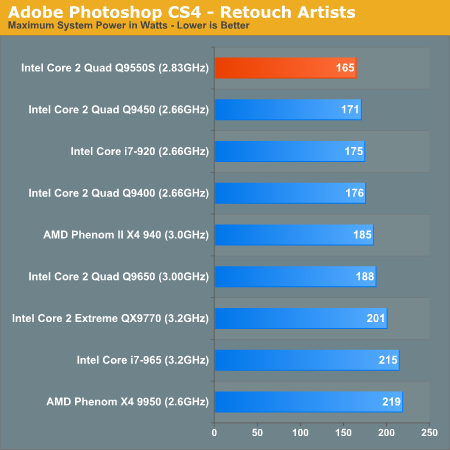
The Q9550S’ advantage amounts to around 15W under peak power draw.
Efficiency is equally important, here we’re looking at total energy consumed by the system over the life of the test. Energy consumed takes into account how long the test takes to complete, which will be shorter on faster machines.
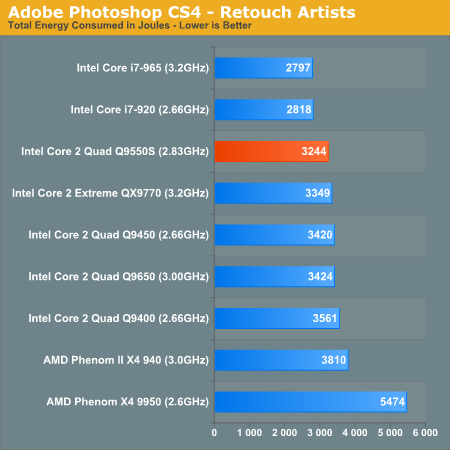
Here the Q9550S is marginally better than its Penryn siblings. There’s about a 5% drop in total energy consumed compared to a Q9650. And this is where the argument for energy efficiency falls short with the Q9550S; look at the total energy consumed on the Core i7, it blows the Q9550S out of the water.
While the Core i7-920 draws as much as 6% more power than the Q9550S, it also completes the benchmark in nearly 14% less time. If you want the best performance per watt, skip the Core 2 Quad Q9550S and buy the Core i7-920.










62 Comments
View All Comments
JPForums - Wednesday, January 28, 2009 - link
In general when people say average, they are talking about the Arithmetic mean.Arithmetic mean = 1/n*(X1 + ... + Xn)
or in English a list of numbers divided by the number of items in the list.
In your case this would mean summing the list of power measurements taken at one second intervals and dividing by the number of measurements which would be the integer number of seconds. You could then calculate joules by multiplying that average by the total time.
The only way the sum of power measurements and calculation made by multiplying the average power by the time would be different is if the number of measurements for the sum and the average are different. In this scenario, the calculation made with more data points would be more accurate (think integration).
So the question becomes: How did you calculate your average? It appears that your average has more data points given that the total test time is measured to 1/10 seconds and your summation was only one second intervals.
That said, the difference between the summation and the result calculated from the average should be small as you stated. The Q9550S results, for instance, only differs by 113(3244-3131) joules and the Core i7-920 differs by a mere 86(2818-2732) joules. Even the Phenom X4 9950 only has a delta of 69(5474-5405) joules. However, the Phenom II 940 has a delta of 898(4697-3799) joules.
This massive difference leads me to suspect that either the average power, the total time, or the total energy for this processor was reported incorrectly. If we assume the average power and the maximum power are the same, then the delta shrinks to 220(4697-4490) joules. Alternately, if we assume that the Phenom II 940 is the same speed as the Phenom 9950, the delta shrinks to 207(4697-4477) joules. Both of the assumptions seem unreasonable to me, and neither get the delta as small as it should be. So I ask, now that I've presented a reasonable case, please recheck your total energy numbers as Ryun suggested.
harijan - Tuesday, January 27, 2009 - link
It still it doesn't make sense. How can it use 4700 joules yet average 157 watts over 24 seconds? Or have a max of 188 Watts?4697 Joules / 24.2 seconds = 195 Watts average
Anand Lal Shimpi - Wednesday, January 28, 2009 - link
Woops, you're completely right :) The issue wasn't with the power measurement but with the performance. The performance data for the run that I measured power under was incorrect. A re-run fixes that problem. The Q9450 was also impacted slightly.It's worth mentioning that the performance and power data are taken at two different times. First the performance data, then the power data. The performance during the power run is close but not always identical to the performance during the performance run. There's going to be some variation depending on the test.
Take care,
Anand
GourdFreeMan - Wednesday, January 28, 2009 - link
I have to agree. There is something wrong with Anand's methodology. Also, look at his specious reasoning for the difference in processor ranking between his "average" power and the energy consumed in the Fallout 3 section, where the tests are run for the same time interval. He is measuring total system power, so the improved idle efficiency of the Nehalems should already be incorporated in those numbers. Average power draw is by definition total energy consumed divided by time interval over which it is consumed. Either taking instantaneous measurements and treating them as averages for each second or simple human error could be responsible for the discrepancy.JPForums - Wednesday, January 28, 2009 - link
I wouldn't call it suspicious, just a flaw in the procedure. If you have a sine wave and a cosine wave at the same frequency, amplitude, and offset measured once per period, one will look much larger than the other even though they average out to be exactly the same. Likewise, if you have two computers drawing the same average power, but you happen to record one during mostly high fluctuations and the other during mostly low fluctuations, you'll get two very different results.You need more samples to get accurate results. The best method would be to record a power graph using the smallest period possible. Then, integrate the power under the curve. Convert the units to seconds to get energy in joules. Divide by the number of samples to get the average power.
GourdFreeMan - Wednesday, January 28, 2009 - link
JPForums, I appreciate your efforts to elucidate my remarks to Anand, but I must comment on two things. First, the word I used was "specious" not "suspicious". There is a difference, just as there is a difference between "average power draw" and "an average of periodically sampled power draws". These two are only guaranteed to coincide if the samples themselves are average powers or in the limit as the period they are sampled over approaches 0. (The latter remark is directed at your definition of average in the first paragraph of your other post).Ryun - Tuesday, January 27, 2009 - link
I was expecting a much bigger delta compared to the 95W quads in wattage.Ryun - Tuesday, January 27, 2009 - link
Meant to end with, "Thanks for the review."So, thanks. =)
harijan - Tuesday, January 27, 2009 - link
no idle power usage numbers?michael2k - Tuesday, January 27, 2009 - link
Unfortunately 65W is still too hot for a 17" MacBook Pro.